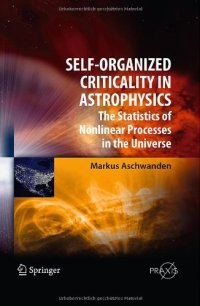
Ebook: Self-Organized Criticality in Astrophysics: The Statistics of Nonlinear Processes in the Universe
Author: Markus Aschwanden (auth.)
- Genre: Physics // Astronomy
- Tags: Astronomy Astrophysics and Cosmology, Statistical Physics Dynamical Systems and Complexity, Geophysics/Geodesy, Extraterrestrial Physics Space Sciences, Statistics for Engineering Physics Computer Science Chemistry and Earth Science
- Series: Springer Praxis Books - Astronomy and Planetary Sciences
- Year: 2011
- Publisher: Springer-Verlag Berlin Heidelberg
- Edition: 1
- Language: English
- pdf
The concept of ‘self-organized criticality’ (SOC) has been applied to a variety of problems, ranging from population growth and traffic jams to earthquakes, landslides and forest fires. The technique is now being applied to a wide range of phenomena in astrophysics, such as planetary magnetospheres, solar flares, cataclysmic variable stars, accretion disks, black holes and gamma-ray bursts, and also to phenomena in galactic physics and cosmology. Self-organized Criticality in Astrophysics introduces the concept of SOC and shows that, due to its universality and ubiquity, it is a law of nature. The theoretical framework and specific physical models are described, together with a range of applications in various aspects of astrophyics. The mathematical techniques, including the statistics of random processes, time series analysis, time scale and waiting time distributions, are presented and the results are applied to specific observations of astrophysical phenomena.
Markus Aschwanden introduces the concept of self-organized criticality (SOC) and shows that due to its universality and ubiquity it is a law of nature for which he derives the theoretical framework and specific physical models in this book. He begins by providing an overview of the many diverse phenomena in nature which may be attributed to SOC behaviour. The author then introduces the classic lattice-based SOC models that may be explored using numerical computer simulations. These simulations require an in-depth knowledge of a wide range of mathematical techniques which the author introduces and describes in subsequent chapters. These include the statistics of random processes, time series analysis, time scale distributions, and waiting time distributions. Such mathematical techniques are needed to model and understand the power-law-like occurrence frequency distributions of SOC phenomena. Finally, the author discusses fractal geometry and scaling laws before looking at a range of physical SOC models which may be applicable in various aspects of astrophysics. Problems, solutions and a glossary will enhance the pedagogical usefulness of the book. SOC has been receiving growing attention in the astrophysical and solar physics community. This book will be welcomed by students and researchers studying complex critical phenomena.